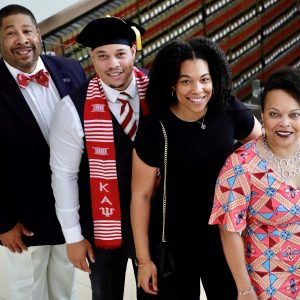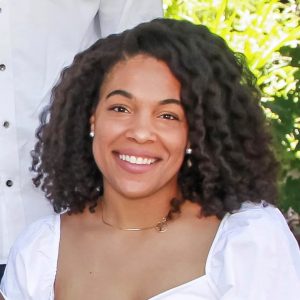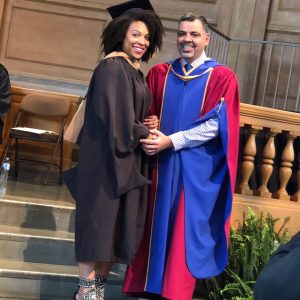Curiosity means asking questions, digging in. It’s what allows us to make progress on some of the world’s most pressing problems – obstacles that can sometimes feel too big to solve. When it comes to these complex problems, where do you begin?
At SAS, we start at the crossroads between insatiable curiosity and powerful analytics.
Ayana Littlejohn, Sr. Associate Analytical Consultant and SAS Black Initiatives Group (BIG) leadership council member is no stranger to asking questions. Her passion for advocacy and limitless curiosity led her to ask tough questions; and months later, her quest for answers has opened doors for progress around the globe.
- Ayana’s family attending her brother’s graduation from law school
- Ayana Littlejohn, Sr. Associate Analytical Consultant
- Ayana and her fiance
- Ayana graduated from Wake Forest University’s Master of Science in Business Analytics program
It began with a question
When SAS’ Social Innovation Summit presented Ayana with multiple data paths to explore, her choice was an easy one: how can we use analytics to protect the most vulnerable populations in our society?
“I’m 100% an advocacy person. I want to see more equitable solutions created for young girls and underrepresented communities,” she shared. “One of the best ways we can support the most vulnerable in our communities is to apply analytics to the most complex problems. That’s how we gain a more complete picture of what lies ahead.”
Along with a team of SAS analytics volunteers, Ayana gained access to the NYC Community Health Profiles. The dataset, which included scores for mortality, premature birth, hypertension, and more, gave the team insight into the personal health of individuals living within the 5 boroughs of New York City.
I’m 100% an advocacy person. I want to see more equitable solutions created for young girls and underrepresented communities.
As the team continued to explore deeper into the data, they began to ask more questions about underrepresented populations and their high incidences of health issues. What was really causing the disparities within the unrepresented communities in these neighborhoods?
“Many areas of New York are food swamps, not food deserts,” Ayana clarified. “There’s plenty of access to food, but most of it is terrible for your health.”
Ayana and the team were determined to find answers: “We turned to the data and wanted to know if these increased scores were caused by genetic makeup or because of what Black and Brown communities have been afforded to put into our bodies?”
An ah-ha moment
Those questions led the team to build a health index that analyzed a multitude of variables, considering health conditions, availability of “healthy” food, number of convenience stores, and more. Using the index, correlations between location and overall health were explored and showed that neighborhoods with higher proportions of Black and Brown populations showed statistically less accessibility to healthy food and significantly higher rates of chronic, underlying conditions.
“There are so many things we [as a society]don’t measure accurately, especially when it comes to how vulnerable populations are portrayed and/or affected,” Ayana explained. “This causes us to overlook the real issues. We have to dig further into the data to find meaningful solutions to commonly held fallacies if we hope to achieve real, lasting change.”
The health index provides a standard to compare specific incidences in correlation to the industry or overarching issue. It helps identify solutions and root causes and provides the ability to ask new questions to better understand the root of the problem.
There are so many things we [as a society] don’t measure accurately, especially when it comes to how vulnerable populations are portrayed and/or affected. This causes us to overlook the real issues.
The success of the index was an ah-ha moment. Because of the flexibility of SAS technology, the team knew that the index could become a repeatable resource – with slight modifications, the index could be used to evaluate and explore the factors driving any inequities present for a variety of global initiatives.
Identifying problems – and finding solutions
Fast forward to today, and the health index has been modified and applied to answer many other complex questions.
Using SAS ® Viya ®, the team has been able to go beyond visualizing the problem to creating a solution. “What we’re able to do now is look into the future and make predictions based on data, so we can be proactive,” she explained. “Visualization is great – it’s the beginning of exploration. But visualization only doesn’t achieve a solution. Our visualizations allow us to see where problems exist, but with SAS Viya we're able to take the next step and build something that reaches a solution.”
The insights derived from these projects provide companies, organizations and governments a basis to create an action plan: “It’s not a one-size-fits-all solution for every problem – it needs to be personalized. We’re able to help give those answers,” explained Ayana. “The index enables that personalization – delivering help faster to those who need it. It helps provide a starting point.”
Outside the office
Outside the office, Ayana enjoys mentoring girls from underrepresented groups in STEM through volunteer work with INTech Camp for Girls and the National Society of Black Engineers (NSBE). After being involved with NSBE as a student at the North Carolina School of Science and Math, Ayana has experienced the impact of the work firsthand:
“These are the careers that make a difference and determine decisions – there needs to be more Black and Brown hands in the development. There isn’t a proportional perspective – not yet,” she shared.
.
Thank you, Ayana, for your amazing work and for sharing your story! Inspired? Take a peek at the #saslife and browse our open jobs.





14 Comments
I must say Ayana is a very enthused individual. She has always had a purpose in life and reading this particular article proves my point. I am proud of you. Keep up the good work.
Thank you! 🙂
That's our Ayana, continuing to make us proud!!
Thanks, Chris! Happy to be a part of our BIG family!
Thank you for the highlight, Alyssa!
Great read! Keep up the good work, Ayana! We need more people like you!
What an awesome highlight! Ayana, you are doing amazing work and I enjoyed working with you on the Malala Fund project.
From the first time I met Ayana in her interview, she really impressed me. I knew she would be a great addition to SAS. Great job Ayana!
Congratulations Ayana. Well done! Good read. Hope to work with you again on a SAS or another mentoring project!
Very nice! Congratulations Ayana.
Awesome article Ayana! You make us NSBE proud!
You are amazing Ayana! So very proud of all your accomplishments!
Great story!
Thanks